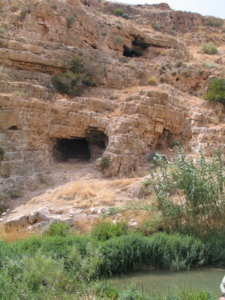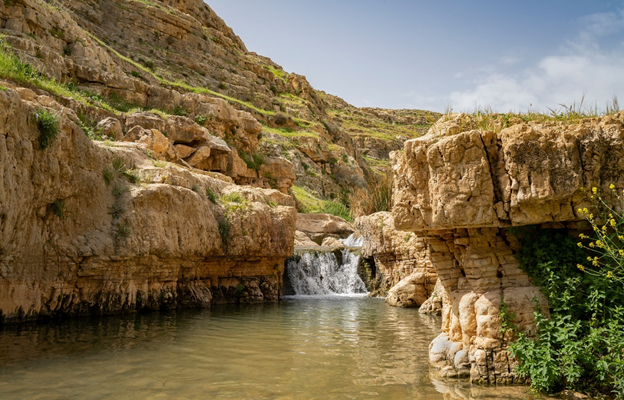
“The words of Jeremiah son of Hilkiah, of the priests who were in Anathoth in the land of Benjamin (Jeremiah 1.1)”
“And the word of the Lord came to me a second time, saying: Take the girdle that you bought and rise, go to Prat (Spring) and hide it there in the cleft of a rock (Jeremiah 13.3)”
By Nosson Shulman, Licensed Tour Guide
Today, we are visiting two special biblical sites in the Judean Desert, as stunning as they are historic. The first is the town of Anatot (Anathoth) and the second is Ein Prat, a desert oasis found in a picturesque canyon (and a great hiking spot)! While these sites are one-of-a-kind and a mere 10 to 15 minutes (drive) from Jerusalem, only a small fragment of tourists visit here.
Our first stop is the town of Anatot (Anathoth) a Jewish town in Judea and Samaria. Founded in 1982 (though the town also existed in Biblical times), the settlement (surrounded by gorgeous rolling hills as far as the eyes can see) currently has 1,546 people living there and is still growing. The stunning views, pastoral quiet and abundance of green space makes this an ideal place to raise a family!
In Biblical times, Anathoth was one of 48 cities given to the Levites (see Joshua 21:18).

Natural caves dot the canyon walls of Ein Prat. In one of these caves, Jeremiah hid the linen belt as G-d commanded. (Wikimedia Commons)
During his reign, King David had 30 generals. One of his generals (Abiezer) was from Anathoth (see 2 Samuel 23:27). He later appointed Abiathar (from Anathoth) as the High Priest. When Solomon was about to take the throne, his half-brother Adonijah tried to usurp the throne and was supported by Abiathar. When King Solomon was inaugurated, rather than putting him to death, he dismissed him from serving in the Temple, telling him to return Anathoth (see 1 Kings 2:26). According to Jewish sources, this was in fulfillment of the prophesy to his ancestor, Eli the High priest, that the high priesthood would soon be removed from his family (see 1 Samuel 2).
Most significantly, Anathoth is the hometown of Jeremiah the Prophet (see Jeremiah 1:1). Not only did he live here, but it is in this vicinity that G-d spoke to him. This is where G-d told him to go to Prat (the Spring found in the canyon just below the town) and to take a linen belt with him. He was to hide it in the clefts of a cave (indeed, one who hikes this trail is treated to the views of many natural caves which have formed in the Ein Prat valley).
After some time, G-d told him to return the cave to retrieve the belt which was now rotten, an allusion to the impending destruction of Jerusalem and exile if the people didn’t repent at the level expected of them.
As a side note, several Bibles written in English translate the Hebrew word “Prat” as the Euphrates River, in modern-day Iraq. To be sure, that mighty river is also called “Prat” in the Holy Language, but according to Jewish sources “Prat” in this case is referring to Ein Prat. They suggest that is proof that G-d likely wouldn’t have sent Jeremiah (who was based in Jerusalem and nearby Anatot) to Iraq twice to retrieve the belt. Rather, since Jeremiah was based near the “Prat” in Israel, it was likely this “Prat” location.
Jeremiah received news of impending exile here, and later was to receive news of future redemption connected to this site. When the prophet was imprisoned in Jerusalem, his cousin Hanamel asked him to purchase his field in Anathoth. Jeremiah knew through prophecy that G-d wanted him to buy this field, so he complied and bought it.

The town of Anatot, nestled among the rolling hills of Judah and Samaria. (Moshe Einhorn/Shutterstock)
The question arises, why would Jeremiah buy a field when he was aware of impending exile? This would seemingly be a bad investment. The answer is that because G-d wanted His people to know that although they may soon be exiled, they would one day return to their homes and fields. Jeremiah was investing his own money to prove that this was true (“Putting his money where his mouth is”). He then gave the deed to his scribe Baruch, the son of Neriah, and told him to store it away in a protected place. (see Jeremiah 32).
A few decades after, the Jewish people returned to re-establish Anathoth, just as Jeremiah had prophesized (Nehamia 11:32). After the great Jewish revolt (circa 66-73 CE) and especially after the Bar Kochba revolt (circa 132-135 CE) the Jewish cities in this area, including Anathoth, were destroyed and its Jewish inhabitants exiled.
In the 4th century CE (circa 330 CE) a monastery complex (one of the world’s oldest) was built inside one of the caves, with the building protruding from the mountain rocks.
Although destroyed by the Persions in 614 CE, it was rebuilt as a Russian Orthodox Monastery at the of the 19th century where it remains today.
By the mid 1920s much of Israel had running water, but Jerusalem itself did not. Almost all drinking water came from collecting rain in cisterns (which was unreliable and often unsafe for consumption). This changed in 1925, when the British built a system of pumps and pipes to bring water to the Holy City from Ein Prat. The pumps would continue to supply water to the Eastern and Northern parts of Jerusalem until 1970, when the Israeli government shut it down. These buildings, though abandoned and no longer in use, can still be seen by visitors of the Ein Prat National Park.
In the last few decades, Jews have been returning to this area en masse. The nearby city of Maale Adumim is the third-largest Jewish city in Judah and Samaria. As G-d had promised through Jeremiah, the area is flourishing (see article on this desert area becoming the new shopping capital of Israel). On your next trip to Israel, if you are looking to visit a site rich in biblical history, gorgeous, natural beauty, and beautiful waters to swim in, consider including this site on your itinerary!
Author’s note: The nature park (where the pools and trails are) is generally considered safe, but some of the beautiful trails do leave the nature park at some point. Although disturbances are rare, it is recommended to check in with the park at the time you wish to visit and to be aware of your surroundings if you choose to do the full hike.
Nosson Shulman is a journalist and Licensed Tour Guide in Israel specializing in Biblical tours. To allow tourists to experience Israel during the Corona era, he created the new hit Israel tour video series, which brings Israel to the home of viewers by simulating actual tours. To check out his free sneak preview tour videos, click here. To view sample tour itineraries or to inquire about private tour opportunities with a personalized itinerary on your next trip to Israel, click here.
Do You Love Israel? Make a Donation to Show Your Support!
Donate to vital charities that protect Israelis and help inspire millions around the world to support Israel too!
Now more than ever, Israel needs your help to fight and win the war -- and also the battle of public opinion.
Anti-Israel bias and boycotts are out of control. Israel's enemies effectively use social media to incite brutal terror against innocent Israeli civilians. Please help us fight back!




